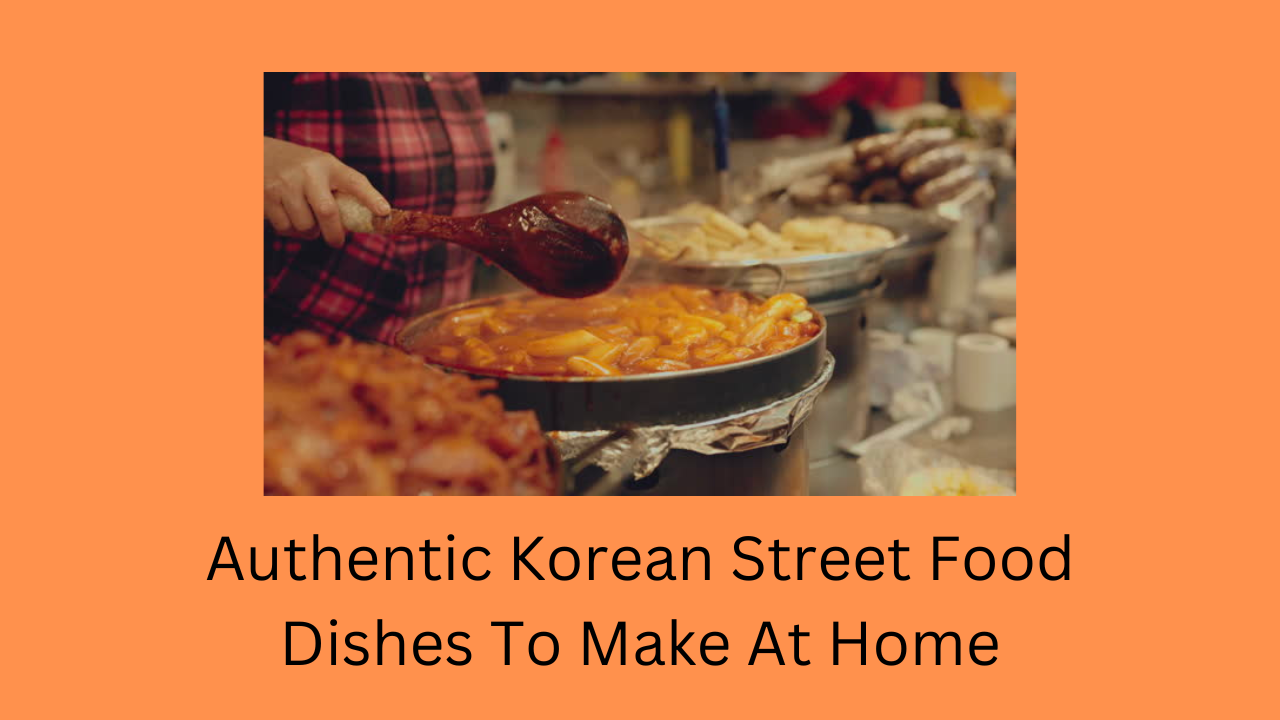Forget fancy restaurants and Michelin stars – the true soul of Korean cuisine lies in its vibrant street food scene. From spicy rice cakes that ignite your tastebuds to fluffy pancakes bursting with sweetness, these portable bites offer a delicious and affordable adventure. But what if you could recreate these culinary gems right in your own kitchen? Buckle up, food lovers, because we’re about to embark on a journey to transform your kitchen into a Seoul street stall!
This post is your one-stop guide to unlocking the secrets of authentic Korean street food. We’ll delve into iconic dishes like the fiery tteokbokki and savory kimchi pancakes, sharing easy-to-follow recipes and handy tips. Get ready to master the art of kimbap rolling, whip up addictively sweet hotteok, and even explore vegetarian and vegan options that burst with flavor.
So, ditch the takeout menus and embrace the vibrant spirit of Korean street food! With a little guidance and a sprinkle of kimchi magic, you’ll be serving up Seoul-worthy dishes that will tantalize your taste buds and transport you to the heart of Korea. Are you ready to get started? Let’s grab our virtual chopsticks and dive in!
What Are Popular Korean Street Foods?

The vibrant streets of Seoul offer a tantalizing array of Korean street food, each dish bursting with unique flavors and textures. Here’s a quick rundown of some of the most popular ones:
Savory Treats
- Tteokbokki:
Spicy stir-fried rice cakes, the undisputed king of Korean street food, in a gochujang-based sauce.
- Mandu:
Steamed or pan-fried dumplings filled with meat and vegetables are a satisfying street food staple.
- Kimbap:
Colorful seaweed rice rolls packed with seasoned rice, veggies, and protein, perfect for grab-and-go meals.
- Kimchi Jjigae:
Spicy kimchi stew with pork or tofu is a comforting and deeply flavorful dish.
- Sundae:
Savory Korean blood sausage, often grilled or skewered and served with a spicy dipping sauce.
- Gimbap:
A smaller version of kimbap, typically filled with just a single ingredient like tuna or kimchi.
- Japchae:
Glass noodles stir-fried with vegetables and meat, a popular and filling street food option.
Sweet Delights
- Hotteok:
Korean sweet pancakes filled with brown sugar, cinnamon, and nuts, are a warm and delicious street treat.
- Dalgona:
Hard candy made with sugar and baking soda, often shaped into playful animals and sold by street vendors.
- Gyeongju Bbang:
Traditional fish-shaped pastries filled with sweet red bean paste, a nostalgic Korean street food.
- Bungeoppang:
Red bean or custard-filled waffle-like cakes shaped like fish, are a cute and tasty street treat.
- Kkwabegi:
Twisted Korean doughnuts, dusted with sugar and cinnamon, are a popular and addictive snack.
Drinks and Toppings
- Odeng:
Fish cakes skewered and simmered in broth, a popular street food snack often enjoyed with mustard sauce.
- Kimchi:
Fermented napa cabbage, is a staple Korean side dish that adds a spicy and tangy punch to street food.
- Soju:
Korean distilled spirit is often served with street food for a refreshing alcoholic accompaniment.
This is just a glimpse into the vast world of Korean street food. Each region and vendor adds their unique twist to these dishes, ensuring endless discovery and culinary adventures. So, next time you’re looking for a taste of Korea, be sure to check out a local street food market and experience the magic for yourself!
Authentic Korean Street Food Dishes To Make At Home
Here are four iconic Korean street food dishes you can easily make at home, even if you’re a culinary novice:
1. Tteokbokki: Spicy Stir-Fried Rice Cakes

Tteokbokki, chewy cylindrical rice cakes bathed in a fiery red sauce, are the undisputed kings of Korean street food. Their sweet and spicy kick, combined with the chewy texture of the rice cakes, is simply addictive.
Ingredients
- 1 lb Korean rice cakes (tteokbokki)
- 1 cup fishcake broth (dashima)
- 1/2 cup gochujang (Korean chili paste)
- 1/4 cup gochugaru (Korean chili flakes)
- 1 tbsp soy sauce
- 1 tbsp brown sugar
- 1 tbsp minced garlic
- 1 tsp toasted sesame seeds
- Optional: Fish cakes (odeng), scallions, boiled eggs
Instructions
- Soak the rice cakes in warm water for 30 minutes to soften.
- In a pot, combine dashima, gochujang, gochugaru, soy sauce, brown sugar, and garlic. Bring to a simmer, stirring occasionally.
- Drain the rice cakes and add them to the sauce. Simmer for 5-7 minutes, stirring gently to coat them evenly.
- Taste and adjust seasonings as needed. Serve hot, sprinkled with sesame seeds and your optional toppings.
2. Mandu: Savory Korean Dumplings

Mandu, steamed or pan-fried dumplings filled with a savory mix of meat and vegetables, are another street food staple. Their crispy exterior and juicy filling offer a comforting bite that’s perfect for any occasion.
Ingredients (for wrapper dough)
- 1 1/2 cup all-purpose flour
- 1/2 tsp salt
- 1/4 cup warm water
Ingredients (for filling)
- 1/2 lb ground pork
- 1/4 cup chopped kimchi
- 1/4 cup chopped Napa cabbage
- 1 scallion, finely chopped
- 1 clove garlic, minced
- 1 tbsp soy sauce
- 1 tsp sesame oil
- 1/4 tsp black pepper
Instructions
- Dough:
Combine flour and salt in a bowl. Gradually add warm water and knead until a smooth dough forms. Cover and let rest for 30 minutes.
- Filling:
Combine ground pork, kimchi, Napa cabbage, scallion, garlic, soy sauce, sesame oil, and black pepper in a bowl. Mix well.
- Assemble:
Divide the dough into small balls and roll them out into thin circles. Place a spoonful of filling in the center of each circle. Fold the dough over to form half-moon shapes and crimp the edges to seal.
- Cooking:
You can steam the mandu for 10-12 minutes or pan-fry them in a little oil until golden brown.
Kimbap: Korean Seaweed Rice Rolls
These colorful seaweed rolls, packed with rice, vegetables, and protein, are the ultimate Korean convenience food. They’re portable, healthy, and bursting with fresh flavors, making them ideal for picnics, lunchboxes, or a light meal.
Ingredients
* 1 cup cooked sushi rice
* 1/2 sheet roasted seaweed (gim)
* 1 carrot, julienned
* 1 cucumber, julienned
* 1/2 cup cooked spinach, drained and squeezed
* 1 can tuna, drained and flaked (optional)
* 1 boiled egg, sliced (optional)
* Sesame oil
* Gochujang (optional)
Instructions
• Spread a thin layer of sesame oil and optional gochujang on the seaweed sheet.
• Place a layer of rice in the center, leaving a 1-inch border at the top and bottom.
• Arrange your chosen fillings (carrot, cucumber, spinach, tuna, egg) horizontally across the rice.
• Tightly roll the seaweed sheet, starting from the bottom and using the rice to hold the fillings in place.
• Slice the roll into bite-sized pieces and enjoy!
3. Kimchi Jjigae: Spicy Kimchi Stew

Here’s everything you need to know about preparing Kimchi Jjigae, a classic Korean spicy stew perfect for both beginners and seasoned cooks:
Ingredients
- 1 lb kimchi, chopped (use older kimchi for a deeper flavor)
- 1/4 cup kimchi brine
- 1/2 lb pork belly, sliced (or tofu for a vegan option)
- 1/2 onion, sliced
- 2 cloves garlic, minced
- 1 green onion, sliced diagonally
- 1 tsp Korean chili flakes (gochugaru)
- 1 tbsp Korean chili paste (gochujang)
- 2 cups beef broth (or vegetable broth for a vegan option)
- 1 tsp toasted sesame oil
- Salt and pepper to taste
Instructions
- Kimchi prep:
In a shallow pot, combine the chopped kimchi and kimchi brine. Let it sit for 10 minutes to release the flavors.
- Searing (optional):
If using pork belly, heat a pan with a little oil and sear the slices until lightly browned. Drain and set aside.
- Sauté:
In the same pan or large pot, heat sesame oil on medium heat. Add the onion and cook until softened about 5 minutes.
- Garlic and spice:
Add the garlic and cook for 30 seconds until fragrant. Then, stir in the Korean chili flakes and chili paste, mixing well.
- Kimchi time:
Add the prepared kimchi and cook for 3-5 minutes, stirring occasionally, to let the flavors meld.
- Broth and simmer:
Pour in the beef broth and bring to a simmer. Add the pork belly (or tofu) and green onions. Simmer for 15-20 minutes, stirring occasionally, until the pork is cooked through and the tofu is infused with the flavors.
- Season and serve:
Season with salt and pepper to taste. Serve hot with rice and additional kimchi on the side, if desired.
Conclusion:
Korean street food offers a diverse and exciting culinary adventure. With readily available ingredients and a little practice, you can recreate these authentic dishes in your own kitchen.
So, gather your friends and family, crank up some K-pop, and embark on a delicious journey through the vibrant flavors of Korean street food! Remember, don’t be afraid to experiment and personalize these recipes to your liking. After all, the heart of Korean street food lies in its creativity and shared enjoyment.

